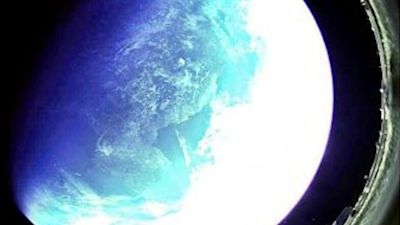North Korea releases images from space taken from its biggest ballistic missile test in years

North Korea has released striking images from space which it said were taken during its most significant missile launch in years.
The country confirmed on Monday that it launched an intermediate-range ballistic missile and released a set of images of Earth, showing parts of the Korean peninsula, via the official Korean Central News Agency (KCNA).
Pyongyang announced it launched the Hwasong-12 missile - capable of reaching the US territory of Guam - off the country's east coast on Sunday as a test to verify the overall accuracy of the weapon that is being deployed in its military.
Sunday’s launch could be a prelude to bigger provocations by North Korea such as nuclear and long-range missile tests that pose a direct threat to the US mainland.
It comes as the North tries to further pressure President Joe Biden's administration to win sanction relief or international recognition as a legitimate nuclear state, as Washington plans steps to show its commitment to its Asian allies.
White House officials said they saw the latest missile test as part of an escalating series of provocations over the last several months that have become increasingly concerning.
South Korean and Japanese officials also condemned Sunday’s launch, which violated U.N. Security Council resolutions that bans the country from testing ballistic missiles and nuclear weapons.
North Korea said the missile was launched toward waters off its east coast on a high angle to prevent flying over other countries. It gave no further details.
According to South Korean and Japanese assessments, the missile flew about 800 km (497 miles) and reached a maximum altitude of 2,000 km (1,242 miles) before landing in waters between the Korean Peninsula and Japan.
KCNA published two sets of combination photos - one showing the missile rising from a launcher and soaring into space, and the other showing North Korea and nearby areas that it said were photographed from space by a camera installed at the missile’s warhead.
However, the authenticity of the photos could not be verified.
Lee Choon Geun, a missile expert and honorary research fellow at South Korea’s Science and Technology Policy Institute, said he thinks the photos were taken from space - especially when the missile was soaring to its apogee, though he cannot independently prove there was no adjustment on the images.
While it’s rare to place a camera on a weapon, Lee said North Korea likely wanted to demonstrate its technological advancement to both foreign and domestic audiences.
In recent months, North Korea has launched a variety of weapons systems and threatened to lift a four-year moratorium on more serious weapons tests such as nuclear explosions and ICBM launches.
Sunday’s launch was the North’s seventh round of missile launches in January alone, and other weapons tested recently include a developmental hypersonic missile and a submarine-launched missile.
The Biden administration plans to respond to the latest missile test in the coming days with an unspecified move meant to demonstrate to the North that they are committed to allies’ security in the region, according to a senior official who spoke to reporters on the condition of anonymity.
They said the administration viewed Sunday’s missile test as the latest in a series of provocations to try to win sanctions relief from the US.
Washington again called on North Korea to return to talks but made clear it doesn’t see the sort of leader-to-leader summits Donald Trump held with Kim Jong-un as constructive at this time.
The reported flight details make it the most powerful missile North Korea has tested since 2017, when the country launched Hwasong-12 and longer-range missiles in a torrid run of weapons firings to acquire an ability to launch nuclear strikes on US military bases in Northeast Asia and the Pacific and even the American homeland.
The Hwasong-12 missile is a nuclear-capable ground-to-ground weapon with a maximum range of 4,500 km (2,800 miles) when it’s fired on a standard trajectory.
It’s a distance sufficient to reach Guam, home to US military bases that in past times of tensions sent advanced warplanes to the Korean Peninsula in shows of force.
In August 2017, at the height of animosities with the then-Trump administration, North Korea threatened to make “an enveloping fire” near Guam with Hwasong-12 missiles.